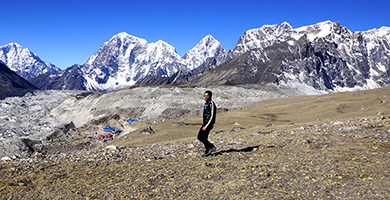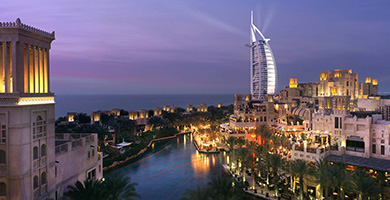Nirvana in Nepal – Part I
 In Nepal, “Namaste” is the customary form of greeting. When spoken, a person places their palms together in front of their chest as if in a prayer gesture, slightly bows their head and salutes you in this beautiful and gentle manner. Namaste represents the belief that there is a divine spark in all of us. It means, I honor the divine in you–that place in you were the whole universe resides, and when I am in that place in me and you are in that place in you, we are one. Namaste is spoken at the beginning, however upon departure only the wordless hands-folded gesture is made.
In Nepal, “Namaste” is the customary form of greeting. When spoken, a person places their palms together in front of their chest as if in a prayer gesture, slightly bows their head and salutes you in this beautiful and gentle manner. Namaste represents the belief that there is a divine spark in all of us. It means, I honor the divine in you–that place in you were the whole universe resides, and when I am in that place in me and you are in that place in you, we are one. Namaste is spoken at the beginning, however upon departure only the wordless hands-folded gesture is made.
In Nepal, religion is not just a set of beliefs and accompanying rituals handed down from generation to generation; rather it is a complex intermingling of traditions, festivals, faiths, and doctrines that have permeated every strata of Nepalese society in such a way as to become the very heartbeat of the nation. Nepal is famous as the world’s only Hindu Kingdom. However, it is an intricate and beautiful tapestry formed by the interweaving of Hinduism, Buddhism and other beliefs. Religious tolerance and harmony such as is found in Nepal, is perhaps a unique example to the world.
The Nepalese people are made up of over 40 different races and tribes yet carry a strong sense of national pride. Nepal has eight World Heritage sites (Durbar Squares of Hanuman Dhoka in Kathmandu, Patan and Bhaktapur, the Buddhist stupas of Swayambhu and Bauddhanath, and the Hindu temples of Pashupati, Changu Narayan, and Lumbini–the birthplace of the Lord Buddha) and has won two Heritage Awards–one for the medieval city of Bhaktapur and the other for the Dwarika’s Hotel in Kathmandu.
KATHMANDU
Dwarika’s Hotel, only twenty minutes from the airport, is the perfect place to stop and rest either before or after you attempt to summit Everest; self-described as a living tribute to Nepal’s architectural and cultural heritage, it is a shining example of national pride, designed to be shared with locals and visitors. The magnificence of Dwarika’s can be found in its antique buildings of intricately carved wood and terracotta work that showcase the handiwork of the best craftsmen in Nepal over many decades. Every brick is handmade and every piece of woodwork a centuries old original. Dwarika’s is not only about intimate luxury, but it also reflects the beautiful spirit and hospitality of the Nepali people that can be found throughout the country.

Founded and conceived by the late Dwarika Das Shrestha, this unique hotel stands as his legacy. It began with an early morning jog back in 1952 when Das Shrestha passed some carpenters cutting up two beautifully carved and engraved wooden pillars, which only hours before had been part of an old building, demolished to make way for a contemporary structure. Amidst the rubble he noticed bits of centuries’ old woodwork, destined for firewood. Something in Das Shrestha’s heart broke. To him, this represented not only the destruction of something fine and lovely, but a loss of his and all Nepal’s ancient culture as well. On impulse, he convinced the workmen to exchange the damaged pillars for money plus new lumber. Thus began a quest to protect his nation’s wooden heritage that continues today. Leading hundreds of the best builders and craftsmen, he dedicated the best part of his life to its development. As the first recipient of the prestigious PATA (Pacific Asia Travel Association) Heritage Award, Dwarika’s Hotel is a living example that tourism need not destroy cultural heritage and the environment, and that the preservation of historical artifacts can contribute to the growth of skills and a culture that might otherwise be lost. At Dwarika’s, Das Shrestha’s spirit and that of a bygone era lives on within its sequestered courtyards where a terracotta pillar–a first of its kind–stands proudly, an example of superb craftsmanship for all to enjoy and admire.
A woodcarving school has also been established within the hotel premises. There are thirty woodcarvers and carpenters employed in the school’s workshop. Some have been there for twenty years while others move on to different lucrative jobs after their training and apprenticeship. Dwarika’s has several community outreach programs as well as a foundation and a school.

Dwarika’s Hotel contains 74 rooms and suites, each with its own individual layout and character. The rooms come with all the modern comforts and amenities that you might not expect in a heritage hotel, yet contain period furniture and striking handmade fabrics. For VIP guests, such as Richard Gere or Joanna Lumley on her recent trip to Kathmandu, there is a self-contained penthouse Royal Suite offering private butler service and panoramic views of the mountains and Kathmandu Valley. Accommodations are housed in several buildings facing the sun-dappled cobbled courtyards filled with old fruit trees like the persimmon. Two deluxe rooms claim huge sunken baths with glass walls overlooking private walled gardens. Organic soaps and beauty products made from fragrant Nepali herbs and ingredients are found in all the bathrooms. In every room, a coffee table holds a traditional Nepalese game, described as somewhat similar to Chinese checkers, shaped like a gold foil tiger.

The hotel has a glorious swimming pool perfect for a cool dip after a day of sightseeing and also offers in-room massages with expert therapists. The candlelit courtyard is a delightful refuge in the evenings from the chaos and grime of the city’s streets. Guests can enjoy the dulcet tones of a flautist and watch a gorgeously costumed classical dancer perform in front of a 13th century carved doorway while sipping a cocktail.
Moving on to dinner at Dwarika’s Krishnarpan Restaurant, diners are greeted by waitresses from various Nepalese ethnic groups clad in traditional dress, each outfit authentic and unique, from the jewelry to the headdress. Low wooden chairs with thick comfy cushions are aligned along tables designed with centuries old lattice woodwork in the two dining rooms. Red and black predominate and the décor includes intricately carved frames around the mirrors. Waitresses pour rice wine from silver Newari vessels, each topped, as tradition dictates, by a bird. Plates, bowls, crockery, and glasses are crafted in traditional style and menu cards of handmade Nepali paper are individually inscribed with each guest’s name. Krishnarpan prides itself on the art of dining, so a typical meal features six to 16 courses and can be best described as a “culinary tour of Nepal.” Signature dishes are highlighted by aromatic and tasty Nepali spices or herbs. Altogether, the gentle grace of the waitresses, the elegant service, and the artful arrangement of each dish combine to create a highly memorable dining experience. The Terrace courtyard restaurant offers alfresco dining with lighter international dishes (Continental, Chinese and Indian specialties) from the Toran Restaurant and Gardens. The original family cottage houses the Fusion poolside bar, curiously filled with Hollywood memorabilia, where live jazz music is sometimes played. There is also a cozy library lounge with a fireplace for afternoon tea or an exclusive meeting. Whatever your mood, need or desire, Dwarikas will serve as a divine base camp for the rest of your trip, so much so, that you may never want to leave. In which case, you can always take advantage of the Special 28 Nights Package that reduces the costs to just US$95 p/night.
[simpleflickr set=”72157622014555345″ /]
Stay tuned for Part II when wandermelon takes you up into the mountains to the Dwarika’s Himalayan Shangri-La in Dhulikhel, the hippy mecca and capitol of adventure in Pokhara, and on to the Jomsom Trail in the Mustang region.
Contact: Dwarika’s Hotel –PO Box 459 , Battisputali. Kathmandu, Nepal / Tel: +977/1-470-770 or 977/1-479-488 / Fax: +977/1-471-379 / E-mail: info@dwarikas.com.
Rates: Rooms at Dwarika’s Hotel start at US$135 single and $155 double for superior rooms, $175 single and $195 double for deluxe rooms and $300 to $1,500 for suites. Lunch at Dwarika’s Krishnarpan restaurant is $13 for four courses. Dinners are: $19 for six courses, $22 for nine courses, $25 for 12 courses and $28 for 16 courses. See website for more special offers: www.dwarikas.com
Facilities & Services: At Dwarika’s Hotel, these include airport transfers, car rentals, currency exchange, laundry, a business center, meeting center accommodating up to 100 persons, a library of travel and cultural books, travel services, safety deposit boxes, shuttle service for shopping, and Tai Chi, yoga and Qi Gong daily in the garden. The hotel can also assist you with any sightseeing trips to explore the city’s famous temples, markets, and squares.
Latest posts by Kate Ayrton
- Paradise Found on Ratua Island, VANUATU - September 2, 2016
- The LA Layover - March 25, 2015
- Manna from Mudgee: NSW, AUSTRALIA - December 1, 2014





[…] Read more: Nirvana in Nepal – Part I […]
[…] its development. As the first recipient of the prestigious … Go here to see the original: Nirvana in Nepal – Part I – Wandermelon Share […]
Dwarika’s – great place to stay and eat. Looking forward to the adventure Part2…pokhara/jomson
That was quite an impressive review! Having inspected the place myself, I couldn’t possibly agree more to what you have written. I hope all other readers hold the same opinion and would like to thank you for your nice piece of work. Keep it up!